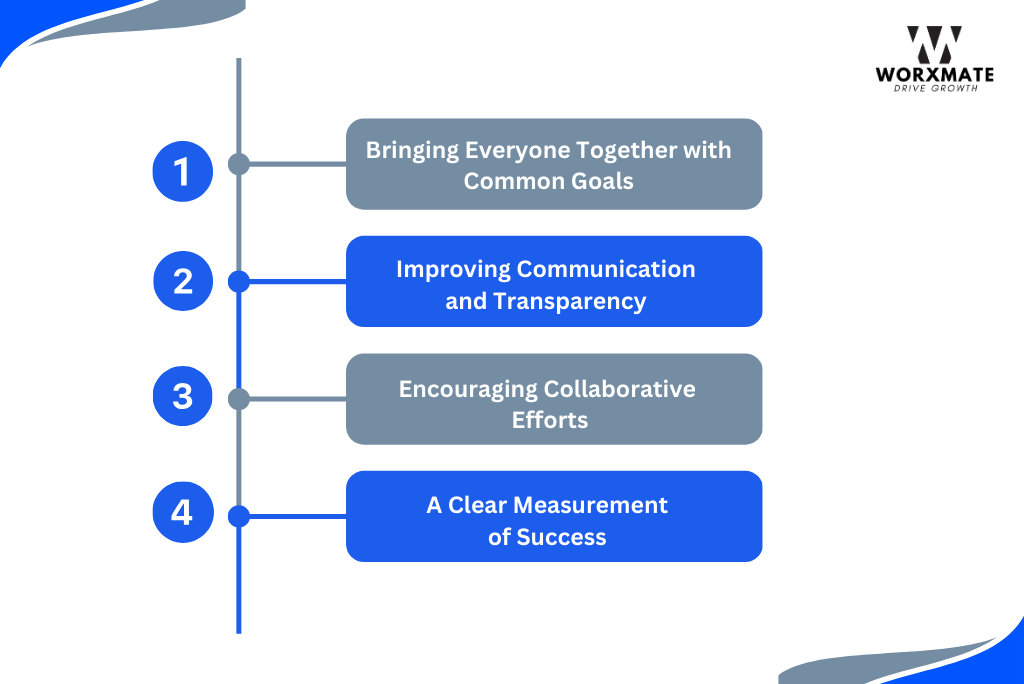Cross Functional teams In today’s dynamic business landscape, the synergy of cross-functional teams is essential for innovation and achieving strategic goals. Cross-functional teams, composed of members from various departments such as marketing, engineering, and sales, bring diverse perspectives and expertise to the table.
However, aligning these diverse teams can be challenging. Objectives and Key Results (OKRs) provide a strong system that helps these teams align, focus, and execute effectively. Here’s how OKRs can significantly improve the performance of cross-functional teams.
» What are OKRs?
OKRs are a goal-setting framework that help organizations set clear, measurable objectives and track their progress through specific key results. This approach helps everyone stay aligned and engaged around common goals.
» The Benefits of OKRs for Cross-Functional Teams

- Bringing Everyone Together with Common Goals
OKRs help cross-functional teams by establishing shared objectives that create a unified vision. This alignment ensures that every team member, whether from marketing, engineering, or sales, works towards the same overarching goals. A study by Deloitte found that companies with aligned teams are 2.2 times more likely to be top performers in their industry.
For instance, let’s consider a tech company aiming to increase its market share by 15% over the next year. By setting the objective to launch a new product feature, the company can use OKRs to align its teams. Marketing’s key results might include generating a 30% increase in pre-launch engagement through targeted campaigns, while engineering focuses on delivering the feature with zero critical bugs by the launch date.
This synchronised effort helps ensure that marketing and engineering work together effectively, leading to a more successful product launch. By aligning their efforts with clear OKRs, the company is better positioned to achieve its goal of increasing market share, demonstrating how a unified approach can drive significant business results.
- Improving Communication and Transparency
OKRs promote transparency and open communication. When everyone understands the objectives and key results, it becomes easier to discuss progress, address challenges, and celebrate successes. Regular check-ins and updates keep everyone informed and on track. A Harvard Business Review study found that 70% of employees feel more engaged when senior leaders continually update and communicate company strategy.
Imagine a cross-functional team at a tech company working to improve customer satisfaction with the objective of enhancing the user experience to boost market share. By setting key results like reducing response times from 24 hours to 4 hours and increasing customer feedback scores from 70% to 85%, the team can track progress effectively.
Weekly check-ins allow the team to review these metrics, discuss any obstacles, and adjust strategies as needed. This regular communication ensures that all departments—marketing, engineering, and customer support—are aligned and working towards the same goal. With OKRs, the team can quickly identify areas needing improvement and make data-driven decisions, ultimately contributing to a projected 15% increase in market share over the next quarter.
- Encouraging Collaborative Efforts
Setting shared objectives through OKRs fosters a highly collaborative environment, enabling team members to leverage their diverse perspectives and skills effectively. Research by McKinsey shows that teams that collaborate effectively are five times more likely to be high performing.
For instance, consider a tech company aiming to launch a new product feature to increase its market share. By using OKRs, the sales team can focus on gathering and analyzing customer insights to ensure the feature meets market demands, while the product team concentrates on developing and refining the design.
Simultaneously, the marketing team can craft targeted campaigns to maximise pre-launch buzz. When these teams set and track shared OKRs, such as achieving a 30% increase in market share within six months, their coordinated efforts are streamlined and more impactful.
The combined focus and alignment provided by OKRs not only ensure that each department’s efforts are in sync, but also help drive substantial growth in market share, as the product feature becomes more successfully launched and adopted by the target audience.
- A Clear Measurement of Success
OKRs provide a clear framework for measuring success. Key results offer specific, measurable targets that teams can aim for, helping everyone understand what success looks like and whether they are on track to achieve it. According to a survey by the American Management Association, 85% of companies say that clearly defined objectives and key results are crucial for their success.
» Real-World Impact
- Intel’s Implementation of OKRs: Intel, a pioneer in the tech industry, successfully implemented OKRs to streamline its processes and improve focus across teams. The framework enabled Intel’s cross-functional teams to align their objectives, resulting in enhanced innovation and productivity.
- Increased Employee Engagement: Organizations using OKRs report higher levels of employee engagement. Clear goals and measurable progress foster a motivated and committed workforce.
- Enhanced Performance: Companies that implement OKRs often see significant improvements in performance and productivity, as the focus on key results drives teams to achieve more efficiently.
Conclusion
Implementing OKRs in cross-functional teams leads to better alignment, improved communication, increased collaboration, and clear measures of success. By setting and tracking shared objectives and key results, teams can work more effectively towards their common goals.
As the business environment continues to evolve, the importance of structured goal-setting frameworks like OKRs will only grow, making them an essential tool for any organization striving for success.
Ready to supercharge your team’s performance with the best OKR software? Try Worxmate today and experience seamless goal alignment and collaboration. Get OKR Demo!



